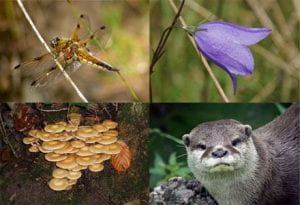At first sight, the error rate of more than 50% for dinosaur species seems to differ hugely from such error rates estimated from other groups. This issue has become an important theme in discussions of biodiversity (Wilson 1992; May & Nee 1995; Alroy 2002; Wortley & Scotland 2004). A fundamental aspect of modern conservation biology is to know how many species in a region, or worldwide, we are seeking to protect. If the standard species lists are riddled with errors, then any further analysis, or practical conservation action, is seriously undermined.
In classic works on biodiversity, Wilson (1992) and May & Nee (1995) assumed a global synonymy rate of 20-22 per cent for living species, and this they felt was probably more or less constant for all groups of plants and animals. However, later studies showed that rates varied enormously between groups – from 7 to 80 per cent (mean 31%) among insect groups (Gaston & Mound, 1993), and from 33 to 88 per cent (mean 66%) among seed plants (Wortley & Scotland 2004).

In order to attempt to estimate true synonymy rates, Solow et al. (1995) presented a modelling approach to take account of recently named taxa. In a case study, they found that the error rate for thysanopteran insects is 22 per cent, based on a survey of all 6112 named species. They then fitted a probability distribution to the year-by-year count of synonym and error discovery to reach an estimated actual error rate of 39 per cent, roughly twice the static estimate. Alroy (2002) stressed that acts of invalidation are themselves subject to scrutiny, and species once invalidated may subsequently be revalidated. So, he applied a ‘flux ratio’ approach to his dataset of North American fossil mammals, and found a corrected error value of 50 per cent, compared with the static estimate of 31 per cent invalid taxa.
So it seems that the earlier estimate of a 20-22% error rate for studies of modern biodiversity and conservation biology might be too low. Further, rates vary between groups, perhaps depending on the anatomy of the organisms, their geographic, sexual, ontogenetic, and individual variation and other biological factors.
Human factors may also be important – the kinds of characters people chose to use traditionally, the influence of individual workers or teams, and the influence of different data sets (anatomy, ecology, molecular sequences) in making species determinations. The intensity and frequency of major revisions may also be critical: if a group is little studied, and taxonomic work is dominated by a small number of workers, revision (and hence then identification of earlier errors) might be infrequent and undemanding. In other case – and this is almost certainly true of dinosaurs – there are many systematists who regularly criticize each other’s work, and there are regular synoptic publications in which wholesale revisions are presented.
Read more about the study
- Error in naming dinosaurs
- Naming organisms and biodiversity
- Naming and revision
- The dinosaur discovery curve
- (With all the money in the world) How to find new dinosaurs
- Who named most dinosaurs?
- Are we getting any better at it?
- Home – dinosaur names, error, and biodiversity
References
- Alroy, J. 2002. How many named species are valid? Proceedings of the National Academy of Sciences, USA 99, 3706-3711. (doi:10.1073/pnas. 062691099)
- Gaston, K. J. & Mound, L. A. 1993. Taxonomy, hypothesis-testing and the biodiversity crisis. Proceedings of the Royal Society of London, B 251, 139-142. (doi:10.1098/rspb.1993.0020)
- May, R. M. & Nee, S. 1995. Taxonomy: the species alias problem. Nature 378, 447-448. (doi:10.1038/378447a0)
- Solow, A. R., Mound, L. A. & Gaston, K. J. 1995. Estimating the rate of synonymy. Systematic Biology 44, 93-96. (doi:10.2307/2413485)
- Wilson, E. O. 1992. The diversity of life. London, UK: Penguin.
- Wortley, A. H. & Scotland, R. W. 2004. Synonymy, sampling and seed plant numbers. Taxon 53, 478-480. (doi:10.2307/4135625)

